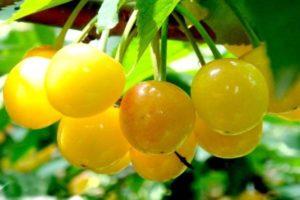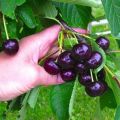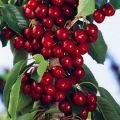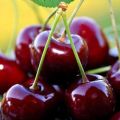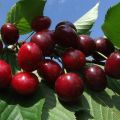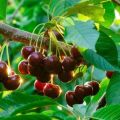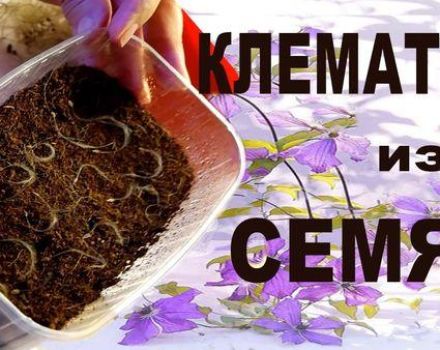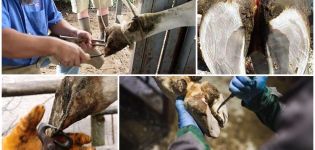Description and characteristics of the Veda cherry variety, cultivation and care
Cherry Veda is well known in gardening circles as a fast growing and winter hardy crop. It is included in the group of new varieties with a high degree of frost resistance; it was added to the State Register in 2009. Due to the late flowering period, the risk of freezing of its fruit buds is reduced to almost zero. To grow a healthy and richly fruiting plant, you need to know its strengths and weaknesses, the main points of planting and care.
The history of the origin of the Veda cherry
This rather promising variety was bred at the V.R. Williams VIC Federal Research Center. Cherry Veda is a product of domestic selection, it was obtained thanks to the efforts of M.V. Kanshins, A.A. Astakhova and L.I. Zueva. The fruit crop was accepted for state testing in 2007.
Advantages and disadvantages: is it worth planting on the site?
Experienced gardeners distinguish among the positive characteristics of Veda cherries:
- excellent consumer and commercial qualities;
- a high degree of resistance to adverse environmental factors;
- frost resistance (up to -30 degrees);
- friendly ripening of fruits;
- fruit buds do not freeze;
- the degree of survival in a permanent place is excellent;
- relative unpretentiousness to growing conditions;
- the possibility of cultivation in regions with cold climates.
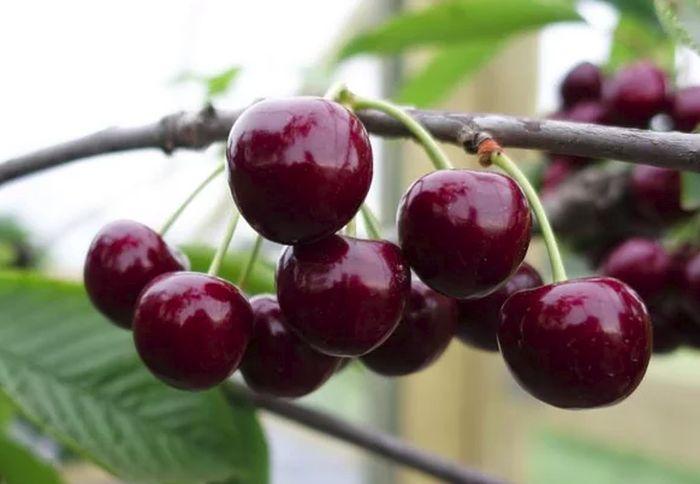
But when growing this fruit crop, some disadvantages were noticed:
- the need for pollinating plants;
- drought resistance is average;
- need protection from diseases and parasitic individuals;
- long period of entry into fruiting.
Varietal description
Sweet cherry Veda, although it is a thermophilic plant, can grow normally and bear fruit abundantly in the Central region of Russia, such as the Vladimirovskaya, Bryansk, Kaluga, and Moscow regions. And also the Veda cherry is actively cultivated in the Ryazan, Tula and Smolensk regions.
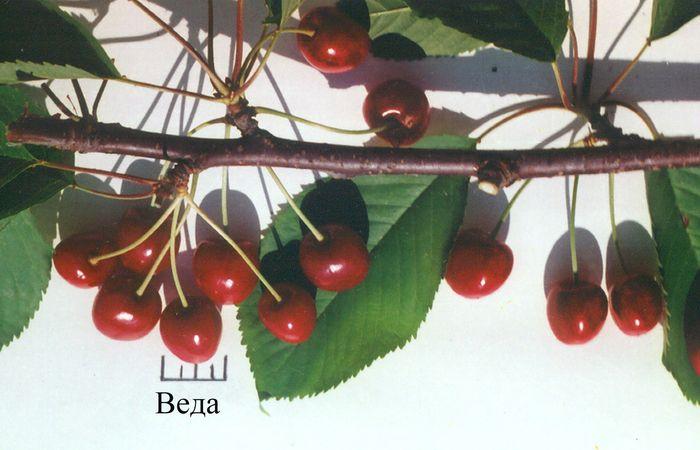
Height and size of the tree crown
The height of the Veda cherry does not exceed 2.5 meters, the growth rate is characterized as quite fast. The spreading dense crown has a rounded shape, the main branches are located at right angles.The color of straight shoots is olive-gray, there is no pubescence on them.
The leaf plates are formed ovoid, there are small denticles along the edges. The surface of the leaf is smooth, without roughness, with a pointed tip. The length of the thick petiole is medium. Inflorescences are formed from white large flowers, their number in each is 3 pieces.

Cherry Veda also attracts the attention of gardeners with its large fruits. Their weight is 5.1 grams, the shape is heart-shaped. The color is dark red, there are subcutaneous dots. Delicate skin and incredibly tasty pulp are the hallmark of the variety.
Cherry Veda was rated by the tasters at 4.6 points. Its sugar content is 11.5%, acidity 0.7%, dry matter almost 18%.
Pollinators, flowering and fruiting
Considering that the Veda cherry belongs to self-fertile plants, in order to obtain a bountiful harvest, it needs additional varieties in the garden. Closest neighbors with similar flowering times should be planted up to 5 meters away. Alternatively, you can graft several other varieties to the cherry and the result will be equally high. For better pollination, it is recommended to carry out a surface treatment with honey dissolved in water, thanks to this technique it will be possible to attract beneficial insects.
The best pollination rates were obtained when planting near Veda cherries of Leningradskaya black, Tyutchevka, Revna, Bryanochka, Iput. This variety enters the fruiting phase 4 years after being assigned to a permanent place. Fruit ripeness occurs in the last days of July.
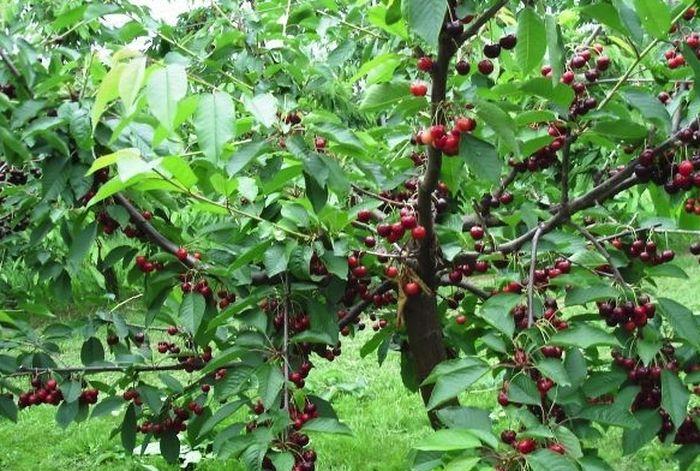
The productivity indicators of Veda cherries reach 40 kilograms from one planting.
Transportability and use of sweet cherries
The fruits of the Veda cherry are distinguished by good keeping quality and are not afraid of transportation over long distances. Their skins are not susceptible to cracking even in conditions of frequent rains. The taste is very sweet, pleasant, pronounced aroma.
The Veda cherry harvest is suitable for the preparation of culinary masterpieces, homemade preparations, and for fresh consumption. The variety stands out for the universal purpose of its fruits. In addition, cherries are suitable for both freezing and baking.
Reproduction of culture
To breed Veda cherries, you can use one of several methods:
- For shoots where only strong young seedlings are used, it is better if these are biennial shoots. They should be located as far away from the mother plant as possible. From summer to autumn, such specimens grow, form a root system, after which they are separated and planted in a prepared place.
- Green cuttings. For this method, branches from the lower tier are suitable, they should have up to five leaves. The cut is performed at an angle using a sharp and decontaminated instrument. For better rooting, the lower leaf plates are removed completely. The blanks are placed in a stimulant solution for 24 hours. After that, cuttings are planted in a soil mixture of peat and sand and covered with a film on the frame to create a greenhouse effect.
- Air layering. On the selected fruiting branch, you need to make a few notches, wrap it with polyethylene with soil and moisten it regularly. After a while, the roots will appear, after which the branch is cut off and planted in a permanent place.
Specifications
Cherry Veda has its own distinctive features, it is able to withstand short-term lack of moisture and tolerate low temperatures.
Frost and drought resistant
Fruit crops react painfully to prolonged dry weather, especially at the stage of flowering and ripening of the crop. Irrigation is one of the important points when caring for a plant. For the variety, negative temperatures are not terrible, it has a sufficient degree of winter hardiness.
Disease and pest resistance
Cherry Veda has an increased immunity to such major diseases as moniliosis and coccomycosis. But against gray rot, gum disease, clotterosporia and powdery mildew, preventive measures are required using special agents such as Bordeaux liquid 1%.
Among harmful insects, cherry Veda is often attacked by cherry fly, weevil and small aphids. Aktara, Aktellik are effectively used against them.
The nuances of planting culture
In order to initially create favorable conditions for growth for Veda cherries, it is necessary to adhere to the basic recommendations for planting seedlings in a permanent place.
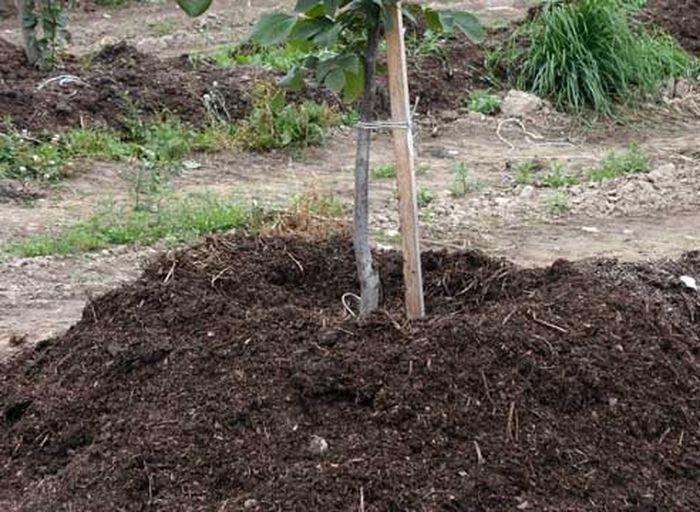
Recommended timing
The optimal time for planting in regions with a warm climate is autumn, one month before the onset of cold weather. But it is recommended to plant seedlings in the middle lane in the spring, when the snow melts. The main thing is to be in time before bud break.
Determining the place
For planting Veda cherries, it is worth choosing glades with good illumination - on the south side of the garden. Since the plant does not like excessive moisture in the soil, the depth of the groundwater should be at least two meters. You should also avoid low-lying areas where cold air is concentrated.
For fruit crops, loamy and sandy loam soil is preferable. It is not advisable to plant the variety in soil with a high content of clay, sand or peat.

Do's and don'ts to plant next to cherries
It is more effective to place cherries near other varieties of sweet cherries, cherries. But next to apple trees, pears and other tall plantings, it is necessary to plant only at a distance of 4-5 meters. It is not advisable to choose a place for planting the Veda near hazel, raspberry, currant, tomato, pepper and potato.
Preparing the seedling and planting pit
It is recommended to use one- or two-year-old seedlings of the variety as planting material. When buying, you should pay attention to the condition of the root system, it should not have traces of rot, signs of disease, various kinds of damage. Before planting, the roots of the Veda cherry tree should be kept for two hours in a container with water, and the leaves should be removed.
Preparatory measures include digging the soil, removing weeds and forming a pit 60 × 80 centimeters. They are carried out 3 weeks before the date of disembarkation. The soil mixture is prepared from the extracted soil and 1 bucket of humus, double superphosphate (150 grams), potassium sulfate (50 grams) or ash (400 grams).
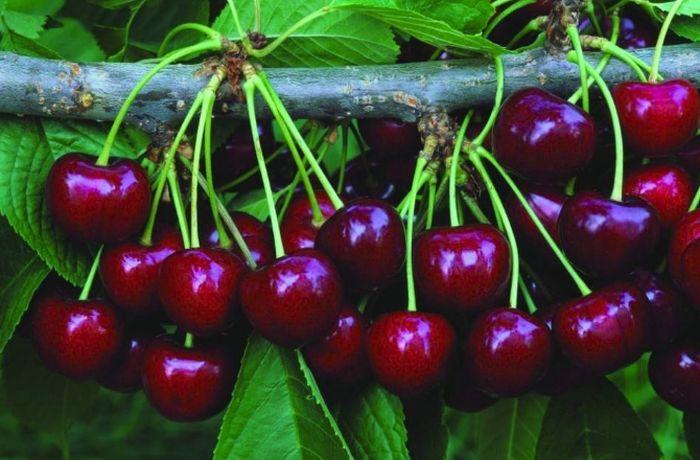
Landing algorithm
The technology of planting cherry seedlings Veda provides for the following actions:
- Laying a drainage cushion 7-10 centimeters thick from expanded clay, broken brick, pebbles in a pit.
- Filling the pit with soil another 15-20 centimeters.
- Placing a plant in the center of the pit and spreading its roots.
- Sprinkling with the remaining fertile substrate and tamping to avoid the formation of voids.
- Formation of grooves around the seedling and abundant watering.
To preserve moisture in the soil, the soil in the trunk circle is mulched with straw, humus, grass.
How to organize proper cultivar care
Among the main activities for the care of Veda cherries are: irrigation, loosening of the soil, removal of weeds, feeding procedures and pruning.
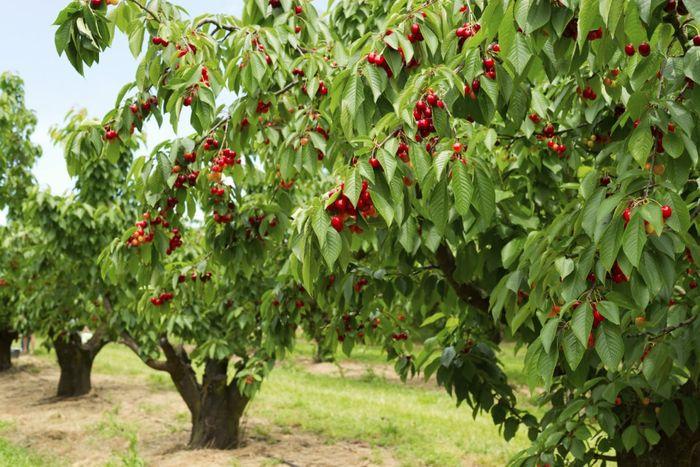
Regularity of watering
Young cherries Veda require irrigation once a week, where 30 liters of water are used per plant. For mature trees that are already bearing fruit, watering is carried out 3 times during the season:
- at the green cone stage;
- with the formation of ovaries;
- at the end of the fruiting phase.
5 buckets of water are consumed per plant. If the summer is dry, then irrigation is done more often. Before wintering, Veda cherries require abundant watering, taking into account 70 liters per plant.
Fertilization
The first feeding procedure is carried out in the spring, when the snow melts, using mullein infusion or urea. In such compositions, a high concentration of nitrogen, which is so necessary for the formation of new shoots. At the end of the flowering phase on the Veda cherry, superphosphate and potassium salt are added, applying 40 grams of each agent to 10 liters of water. It is especially good to combine top dressing with soil moistening.
Formative pruning
The Veda cherries should be pruned every year to maintain a sparse tiered shape. Thanks to such actions, it is possible to increase the productivity of the plant, reduce the risk of harmful insects and various ailments. In each tier there should be three strong shoots, and it is worth getting rid of the incapacitated ones. The procedure is performed in spring or autumn.
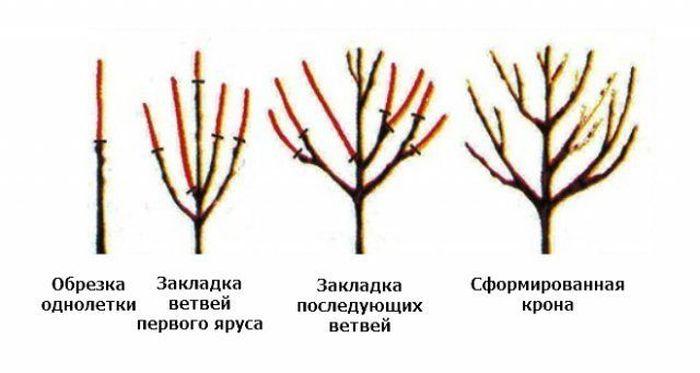
Disease prevention
In order to prevent the progression of fungal diseases such as moniliosis, clasternosporiasis and coccomycosis, they are treated with a solution of copper oxychloride, Hom or Horus. The main thing is not to use strong chemical preparations 20 days before harvesting.
Protection against insects and parasites
To combat aphids, cherry flies and moths on Veda cherries, use Iskra, Aktellik, Karbofos. In the fall, it is imperative to dispose of fallen leaves and dig up the soil.
Variety reviews
Among gardening lovers, reviews of Veda cherries are mostly positive. The culture is appreciated for its sufficient frost resistance and yield. In care, it does not require a special approach, and fruit is stable and abundant.
Victor Pavlovich 62 years old:
Cherry Veda I have known for more than a dozen years, it has always delighted us with its fruits and ease of care. I have never frozen in winter, I recommend this variety to everyone for its ease of cultivation and good yields.
Sveta 41 years old:
The first time Veda learned about cherries from her husband's parents, they are avid gardeners with him. Later they planted this variety of cherries in their own area, at first it did not bear fruit for a long time, but then, when the time came, they did not know what to do with the cherries. Great variety.
